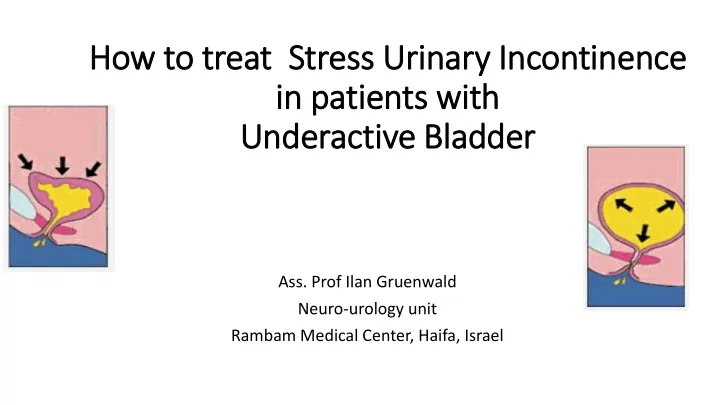

How to treat Stress Urin inary ry In Incontinence in in patie ients wit ith Underactiv ive Bla ladder Ass. Prof Ilan Gruenwald Neuro-urology unit Rambam Medical Center, Haifa, Israel
Underactive bla ladder • Reduced strength of detrusor contraction resulting in prolonged bladder emptying or in a PVR • Often linked to sensory dysfunction : diminished sensitivity to bladder volumes, hypotonicity • It is described by symptoms of hesitancy, poor or intermittent stream, or incomplete bladder emptying. Failure to void
UAB may overlap with BOO, OAB, or SUI • Age-related symptoms such as urinary retention, weak stream, and/or incontinence have been attributed to UAB and suggest that Detrusor Underactivity has age-associated prevalence. Half of elderly men and ¾ of elderly women With Detrusor Underactivity have other urologic conditions such as OAB, BOO, or SUI.
Failure to void (UAB) with failure to store (SUI) • UAB is associated with voiding LUTS, particularly poor flow. • SUI is associated with storage LUTS, particularly “ superflow ” • A state of Bladder underactivity with Urethral sphincter underactivity • The combination of SUI with UAB is clinically beneficial for UAB symptoms. • Theoretically, treating SUI could interfere with bladder emptying and could result in severe voiding difficulty and urinary retention.
Management of f SUI I in in patients wit ith UAB • Treatment should be stepwise and tailored according to basic UAB and SUI severity: • If UAB is severe and the patient is already treated by CIC- treat SUI as Genuine SUI. In the rare case of a successful Sacral neuromodulation therapy - treat SUI as Genuine SUI. • If UAB is mild/moderate , applyng the crede maneuver with/without medications (alpha blockers/cholinergics/combination) could alleviate bladder emptying . SUI could then be treated by pelvic floor rehabilitation (contraction and relaxation).
Management of f SUI I in in patients wit ith UAB • If results are unsatisfactory, and SUI is mild to moderate, introducing a vaginal insert is appropriate (Impresa, Diveen, Nolix)
Su Surgical in interventions for the treatment of SU SUI wit ith UAB • Basically , several studies have shown that lower Qmax before surgery (which is consistent with DU) and patient age are unfavorable predictors for an unfavorable outcome after MUS. • Some studies show that the continence rate after MUS in patients with DU was lower than in patients with normal detrusor function, and was associated with 36% voiding difficulty and significantly Increased PVR.
Should we treat these UAB + SUI patie ients wit ith a mid id urethral l slin ling? • The problematics- applying the sling too loose - persistent SUI, and applying normal tension may cause postoperative voiding difficulty • Tension- free aims to enhance the support of the urethra , as opposed to the sling procedure (which aims to compress the urethra or raise urethral resistance) • TVT and urethral resistance (R = P/Q 2 )
Alternatives to TVT • Bulking agents, laser therapy • An adjustable sling could be a reasonable option- allows control over tension according to the postoperative urine leak or voiding difficulty. • Some studies show high objective and subjective cure rates with adjustable slings, prospective long-term follow-up RCT data are still needed. T. Gateau et al: Clinical and Urodynamic Repercussions after TVT and How to Diminish Patient Complaints. European Urology ,44 (3), 372-376, 2003
Take home messages • UDS should be performed to confirm the presence of DU • UDS may demonstrate false-positive underactivity and may falsely prevent the patient from undergoing MUS. Consider obstructing the bladder outlet to demonstrate true bladder contractility • Better patient preparation, detailed explanation and meeting expectations regarding lower success rate of MUS should be done. • Treatment should be tailored to each patient's main symptom. • Pelvic floor exercise, proper medication and intra vaginal anti SUI devices are all valid optional treatments. • The risk of voiding difficulty after surgery suggests that the use of an adjustable sling should be considered.
Recommend
More recommend